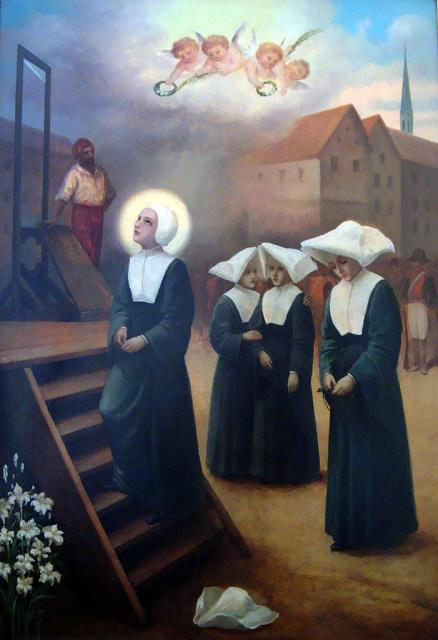アラスの愛徳姉妹会の4人の修道女の
カンブレーでの殉教
1794年6月26日
|
Arras Cambrai |
注)フランス人の人名ですが、読み方に自信があるわけではないし、元よりフランス語の読みは日本語に転記しづらいものですが、一応、無理矢理、時には当てずっぽうで(?)、カタカナにしておきます。
文中の〔 〕は私による付加。
Daughters of Charity of Saint Vincent de Paul
アラスの愛徳の家〔愛徳姉妹会〕の
|
Sisters Marie-Madeleine Fontaine, Marie-Françoise Lanel, Thérèse Fantou, Jeanne Gérard from the House of Charity in Arras

〔或る記事によると、最初に断頭台にあがったのはジャンヌ・ジェラール修女だったようです〕
|
アラスの愛徳の家(House of Charity)は活動の蜂の巣〔比喩〕だった。七人の修道女たちは病人の世話をし、貧しい家庭を訪問し、幼い子供たちを教えなどしていた。彼女らの奉仕活動は地域住民から非常に感謝されていた。
The House of Charity in Arras was a beehive of activity. Seven Sisters cared for the sick, visited poor families and educated young children. The service was very well appreciated by the population.
他のあらゆる場所と同様、革命はそこでもイエズス・キリストと教会に対する一人一人の忠誠を問題視した。Coutacheaux 修女はいち早く実家に帰る決意をした。長上は二人の若い修道女のことを心配していた。革命家らは彼女らにどんな運命を準備しているのだろう?と。彼女は彼女らにベルギーに避難することを勧めた。ローズ・ミショー修女とジャンヌ・ファーブル修女はそうしたくなかったが、恐怖政治がアラスに来た時、助言に従い、避難した。彼女らは、会が再開された時、戻って来た。1793年の終わりに、愛徳の家には四人の修道女が居た。彼女らはそこに残り、働き続けた。
Like everywhere, the Revolution questioned each one’s fidelity to Jesus Christ and to the Church. Quickly, Sister Coutacheaux decided to return to her family. The superior was worried about the two youngest Sisters. What fate did the revolutionaries have for them? She invited them to find refuge in Belgium. Sister Rose Michau and Sister Jeanne Fabre did not want to leave, but once the Terror came to Arras they followed the advice and went into exile. They rejoined the Company of the Daughters of Charity when it was reestablished. At the end of 1793 there were four Sisters, then, who remained working in the House of Charity.
マリー・マドレーヌ・フォンテーヌ修女。ノール県エトレパニーに生まれる。1748年に25歳で入会した。会の長上としての彼女の知恵と能力は非常に高く評価されていた。
マリー・フランソワーズ・ラネル修女。1745年にセーヌ=マリティーム県ウーに生まれる。19歳の時に入会。
テレーズ・フォントゥ修女。1747年にイル=エ=ヴィレーヌ県ミニアック=モルヴァンに生まれる。24歳の時に入会。
ジャンヌ・ジェラール修女。1752年にムーズ県〔マルヌ県の間違い? 参照〕キュミエールに生まれる。1776年に入会。
Sister Marie Madeleine Fontaine, originally from Etrapigny (Eure), entered the Company in 1748 at the age of 25. As Superior of the community, her wisdom and competence were greatly appreciated. Sister Marie Françoise Lanel was born in 1745 in Eu (Seine Maritime). She entered the Daughters of Charity at the age of 19. Sister Thérèse Fantou was born in Miniac Morvan (Ille et Vilaine) in 1747. She became a Daughter of Charity at the age of 24. Sister Jeanne Gérardest was born in Cumières (Meuse) in 1752 and entered the Company of the Daughters of Charity in 1776.
ジョゼフ・レボンがアラスの新地区指導者に着任したことで、暴力と恐怖の空気が市にやって来た。愛徳の家は、修道女たちの活動に目を光らせる新しい監督官が送り込まれた「人間の家(House of Humanity)」になった。侮辱的なことが強まり、虚偽の証言が増えた。1794年2月14日、修道女たちは逮捕され、サン・ヴァースト修道院に送られた。彼女らは、自分の未来について恐れていた囚人たちに深い思いやりを示した。彼女らは4月4日に最初の尋問を受けた。彼女らは、自身の良心に反する故に、宣誓することを再び拒んだ。
The arrival in Arras of a new District leader, Joseph Lebon, brought a climate of violence and fear to the city. The House of Charity became the “House of Humanity” for which a new director was installed who surveyed the activities of the Sisters. The humiliations intensified and the false testimonies multiplied. On February 14 1794 the Sisters were arrested and taken to Saint-Vaast Abbey. The Sisters brought compassion to the prisoners who were distraught about their future. The Sisters underwent their first interrogation on the 4th of April. They again refused to take the oath since it was against their conscience.
その後、突然、6月25日の夜、この4人の愛徳の家の修道女たちを直ちにカンブレーに移すようにとの命令が下された。馬車は午前1時に出発し、午前8時半にカンブレーに到着した。修道女たちは古い神学校の礼拝堂に閉じ込められた。この祈りの場所で、彼女らは黙想した。
Then, suddenly, on the night of June 25, the order was given to quickly transfer these four Sisters of Charity to Cambrai. The cart left at one in the morning and arrived in Cambrai at eight thirty. The Sisters were locked in the chapel of the old Seminary. In this place of prayer they meditated.
それから、新たに法廷に呼び出され、直ぐに死刑判決が出た。自分たちをギロチンまで運ぶ馬車が来るのを待ちながら、修道女たちはチャプレットを祈った。警備兵たちは彼女らの「幸運のお守り」〔警備兵の目にはそう映った?〕を取り上げたが、それをどうしていいか分からず、彼女らの頭の上に冠のように戻した。それから彼女らはアヴェ・マリス・ステラを歌いながら街を抜けて行った。マリー・マドレーヌ・フォンテーヌ修女は断頭台の下で、死刑判決を受けた人々に対して既にしていた予告を再び繰り返した、「私たちが最後の犠牲です」。この普通でない予告は現実となった。1794年7月27日のロベスピエールの転落によって恐怖の革命は終わりを告げた。
Then came a new court appearance and immediate condemnation to death. Waiting for the cart to take them to the guillotine the Sisters prayed their chapelet. The guards took their “good luck charms,” and, not knowing what to do, put them on their heads like a crown. Thus it was that they went through the city, singing the Ave Maris Stella. At the foot of the scaffold Sister Marie-Madeleine Fontaine repeated the prediction already made to those condemned, “We are the last victims.” That extraordinary prediction came true. The fall of Robespierre on July 27 1794 marked the end of the Revolution of Terror.
護送馬車で処刑場まで連れていかれる時、71歳の長上はこのように、民衆に(或いは、知人に?)別れの挨拶をしたようです。

こう見ると、彼女らはあたかも天国への階段をのぼって行くかのようです。地上の論理では「いわれのない罪で死刑にされることのどこが “天国への階段” なんだ」ということになるけれども。
Vincentian Encyclopedia
VinFormation
CatholicSaints.Info
DePaul University Digital Collections
「罪の概念は中世の哲学が聖書の内容を悲観的に解釈したものである、という考えを徐々に刷り込むことによって」